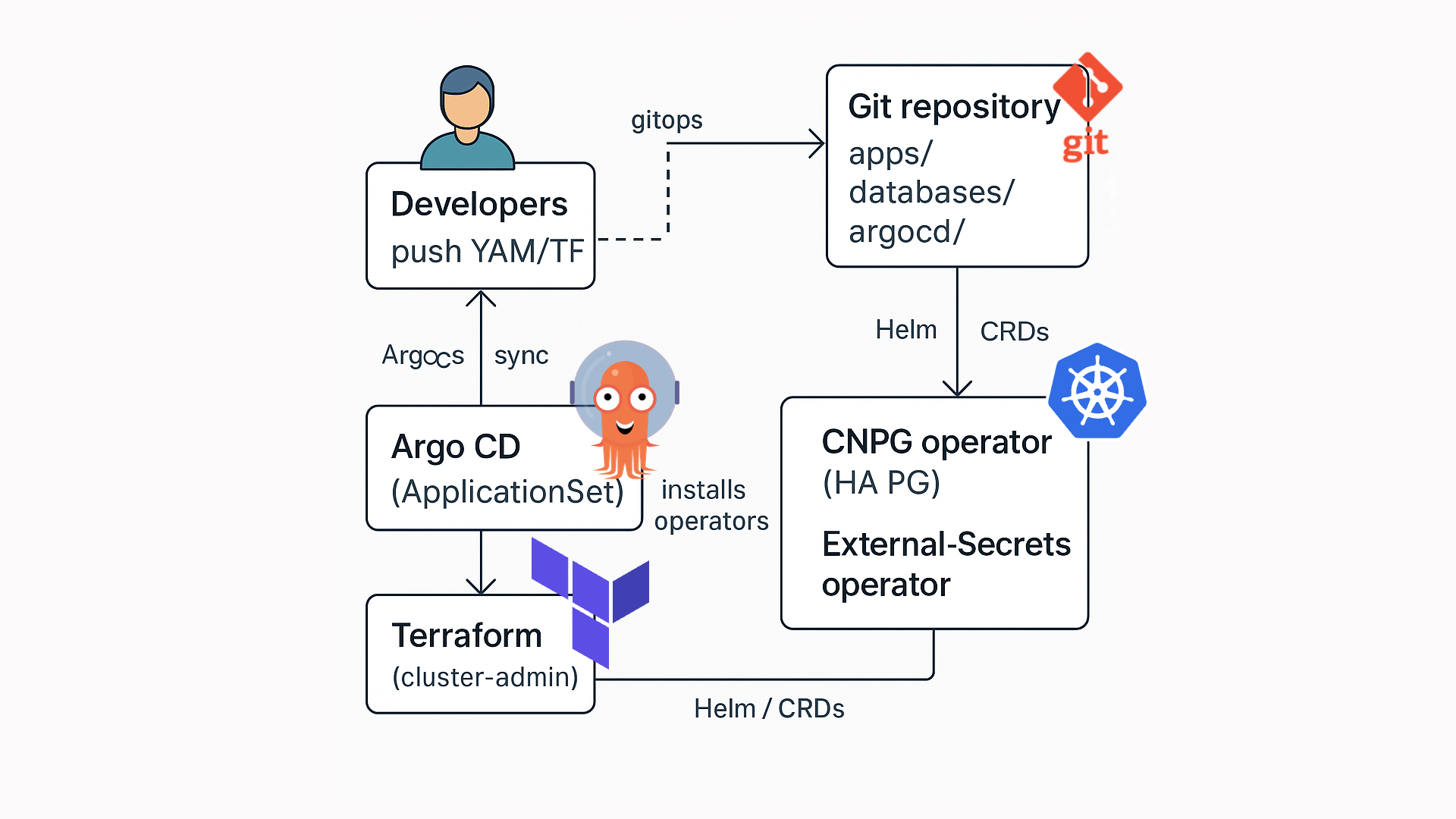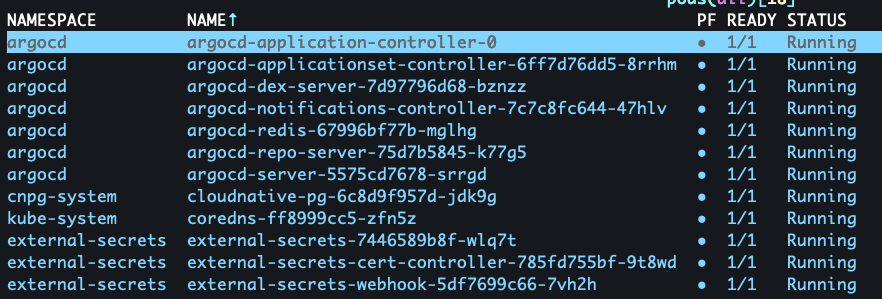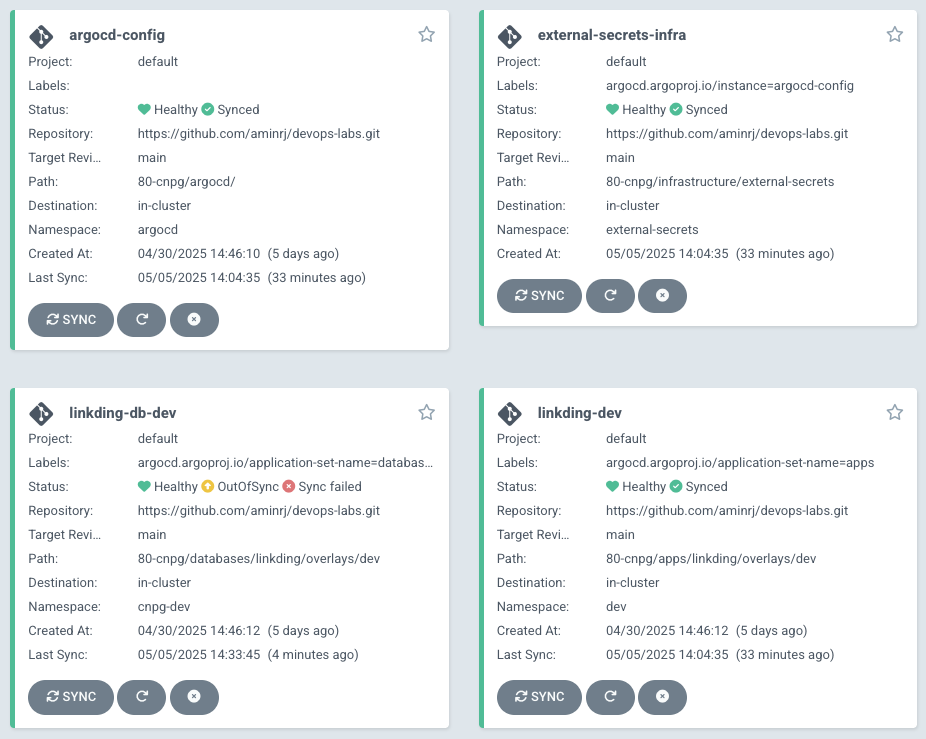How you Should Deploy and Use Postgres in Kubernetes
Bootstrapping a Per‑Application Highly‑Available PostgreSQL Cluster with CloudNativePG, Terraform & GitOps:
A step‑by‑step tutorial using the Linkding bookmark manager as an illustration example.
TL;DR – In ~30 minutes you will spin‑up an application and its own highly‑available Postgres cluster using nothing but Git commits and Terraform. We will rely on CloudNativePG (CNPG) for the database layer, ArgoCD for GitOps continuous delivery, External‑Secrets to bridge secrets from Azure Key Vault, and a few battle‑tested DevSecOps patterns.
1 – Why per‑app HA Postgres?
First, let’s briefly present some arguments on why such setup is sound in the first place:
- Blast radius — a rogue migration or
DELETE FROMonly harms its own cluster. - Tuned resources — memory/CPU, WAL settings, and retention match the workload.
- Security boundaries — each namespace can enforce distinct RBAC & network policies.
- Lifecycle independence — upgrade, snapshot, or drop a database without downtime for others.
Yes, the trade‑off is more clusters to manage – However CNPG makes that almost trivial.
2 – Reference architecture
1
2
3
4
5
6
7
8
9
10
11
12
13
14
15
┌──────────────────────┐ ┌────────────────────────────┐
│ Developers │ git │ Git repository │
│ push YAML/TF ├─────────────▶│ apps/ databases/ │
└──────────────────────┘ │ argocd/ │
▲ gitops sync └──────────▲─────────────────┘
│ │
┌─────────┴────────┐ ┌───┴─────────────┐
│ Argo CD │ applies manifests . │ Kubernetes │
│ (ApplicationSet) ├──────────────────────── ▶│ cluster │
└─────────┬────────┘ └────┬────────────┘
│ Helm / CRDs │
┌─────────▼────────┐ ┌────▼──────────────────────────┐
│ Terraform │ installs operators │ CNPG operator (HA PG) │
│ (cluster‑admin) ├────────────────────────▶│ External‑Secrets operator │
└──────────────────┘ └───────────────────────────────┘
Operators, CRDs and namespaces are installed once via Terraform.
Everything application‑specific lives in Git and is reconciled by ArgoCD.
3 – Prerequisites
| Tool | Version tested | Purpose |
|---|---|---|
| Kubernetes | ≥ 1.27 | Where everything runs |
| Terraform | ≥ 1.5 | Cluster bootstrap & Day‑0 ops |
| ArgoCD | ≥ 2.8 | GitOps engine |
| CloudNativePG | ≥ 1.21 | PostgreSQL operator |
| External‑Secrets Operator | ≥ 0.9 | Sync secrets from Azure Key Vault |
| Azure Key Vault | any | Secret backend |
You also need kubectl, kustomize and a Git repo.
4 – Repository & GitOps layout
Our repo holds three top‑level domains:
1
2
3
4
5
6
7
8
9
10
11
12
13
14
15
16
17
18
19
20
21
22
23
24
25
26
27
28
29
apps/ # application manifests
└─ linkding/
├─ base/
│ ├─ deployment.yaml
│ ├─ service.yaml
│ └─ kustomization.yaml
└─ overlays/
└─ dev/
├─ namespace.yaml
├─ secrets.yaml # ExternalSecret → Azure KV
└─ kustomization.yaml
# A symmetrical layout for the database
Databases/
└─ linkding/
├─ base/
│ ├─ database.yaml # CNPG Cluster
│ └─ kustomization.yaml
└─ overlays/
└─ dev/
├─ scheduled-backup.yaml
├─ secrets.yaml # S3 / Azure Blob creds
└─ kustomization.yaml
# Argo CD owns the sync‑loops
argocd/
├─ applicationset.yaml # applications/
├─ db‑applicationset.yaml # databases/
└─ external-secret-application.yaml
The base directory contains vendor‑agnostic manifests; overlays patch environment‑specific details (Kustomize).
5 – Terraform – bootstrap the operators
Day‑0 steps are performed once per cluster:
1
2
3
4
5
6
7
8
9
10
11
12
13
14
15
16
17
18
19
20
21
22
23
24
25
26
27
28
29
30
31
32
33
34
35
36
37
38
39
40
41
42
43
44
45
46
47
48
49
50
51
52
53
54
55
56
57
58
59
60
61
62
63
64
65
66
67
68
69
70
71
72
73
# terraform/main.tf
terraform {
required_version = ">= 1.5.0"
required_providers {
helm = {
source = "hashicorp/helm"
version = ">= 2.9.0"
}
kubernetes = {
source = "hashicorp/kubernetes"
version = ">= 2.22.0"
}
}
}
variable "kubeconfig" {
description = "Path to your kubeconfig file"
type = string
default = "~/.kube/config"
}
provider "helm" {
kubernetes {
config_path = var.kubeconfig
}
}
# CloudNativePG operator
resource "helm_release" "cnpg" {
name = "cloudnative-pg"
repository = "https://cloudnative-pg.github.io/charts"
chart = "cloudnative-pg"
version = "0.20.1" # matches CNPG 1.22.x
namespace = "cnpg-system"
create_namespace = true
set {
name = "monitoring.enabled"
value = true
}
}
# External‑Secrets operator
resource "helm_release" "external_secrets" {
name = "external-secrets"
repository = "https://charts.external-secrets.io"
chart = "external-secrets"
version = "0.9.16"
namespace = "external-secrets"
create_namespace = true
set {
name = "installCRDs"
value = true
}
}
# (Optional) Argo CD
resource "helm_release" "argo_cd" {
name = "argocd"
repository = "https://argoproj.github.io/argo-helm"
chart = "argo-cd"
version = "5.51.6"
namespace = "argocd"
create_namespace = true
# Reduce footprint for a lab / homelab
set {
name = "configs.params.server.insecure"
value = true
}
}
Running terraform apply would get the initial infrastructure up and running in
the Kubernetes:
6 – Kustomize manifests
apps/linkding/base/deployment.yaml
1
2
3
4
5
6
7
8
9
10
11
12
13
14
15
16
17
18
19
20
21
22
23
24
25
26
27
28
29
30
31
32
33
34
35
36
37
38
39
40
41
42
43
44
apiVersion: apps/v1
kind: Deployment
metadata:
name: linkding
spec:
replicas: 1
selector:
matchLabels:
app: linkding
template:
metadata:
labels:
app: linkding
spec:
containers:
- name: linkding
image: sissbruecker/linkding:latest
ports:
- containerPort: 9090
env:
- name: LD_DB_ENGINE
value: django.db.backends.postgresql
- name: LD_DB_HOST
value: pg-dev-rw.cnpg-dev.svc.cluster.local
- name: LD_DB_PORT
value: "5432"
- name: LD_DB_NAME
value: linkding
- name: LD_DB_USER
valueFrom:
secretKeyRef:
name: linkding-db-secret
key: username
- name: LD_DB_PASSWORD
valueFrom:
secretKeyRef:
name: linkding-db-secret
key: password
volumeMounts:
- name: linkding-data
mountPath: /etc/linkding/data
volumes:
- name: linkding-data
emptyDir: {}
databases/linkding/base/database.yaml
1
2
3
4
5
6
7
8
9
10
11
12
13
14
15
16
17
18
19
20
21
22
23
24
25
26
27
28
29
30
31
32
33
34
35
36
37
38
39
40
41
42
43
44
45
46
apiVersion: postgresql.cnpg.io/v1
kind: Cluster
metadata:
name: linkding-db-dev-cnpg-v1
spec:
description: Postgres cluster for the linkding application
imageName: quay.io/enterprisedb/postgresql:16.1
instances: 3 # High‑availability
storage:
size: 5Gi
monitoring:
enablePodMonitor: true
inheritedMetadata:
labels:
app: linkding-database
policy-type: database
bootstrap:
initdb:
database: linkding
owner: linkding
secret:
name: linkding-db-creds
resources:
requests:
memory: 600Mi
backup:
barmanObjectStore:
destinationPath: https://myblob.blob.core.windows.net/linkding-db
azureCredentials:
storageAccount:
name: linkding-db-storage
key: container-name
storageSasToken:
name: linkding-db-storage
key: blob-sas
wal:
compression: gzip
data:
compression: gzip
retentionPolicy: 14d
With CNPG a read–write service (
*-rw) and a read‑only service (*-ro) are generated for you – we pointLD_DB_HOSTto the former.
7 – ArgoCD ApplicationSets
A single ApplicationSet per domain keeps things DRY:
1
2
3
4
5
6
7
8
9
10
11
12
13
14
15
16
17
18
19
20
21
22
23
24
25
26
27
28
# argocd/applicationset.yaml
apiVersion: argoproj.io/v1alpha1
kind: ApplicationSet
metadata:
name: apps
spec:
generators:
- git:
repoURL: https://github.com/aminrj/devops-labs.git
revision: main
directories:
- path: 80-cnpg/apps/*/overlays/*
template:
metadata:
name: "-" # example: commafeed-dev, listmonk-qa...
spec:
project: default
source:
repoURL: https://github.com/aminrj/devops-labs.git
targetRevision: main
path: "80-cnpg/apps//overlays/" #Example: apps/nextjs-app/dev
destination:
server: https://kubernetes.default.svc
namespace: "" # dev, qa, prod as namespace (simpler - for now)
syncPolicy:
automated:
prune: true
selfHeal: true
Repeat the same for databases/*.
8 – Bootstrapping the database
- Create secrets in Azure Key Vault (
linkding-db-username,password, blob SAS…). - Commit the
external-secrets.yamlmanifest in both app and database overlays – EKS will automatically generate KubernetesSecrets. - Merge to main ➜ ArgoCD applies everything ➜ CNPG operator spins‑up the cluster.
- CNPG initialises
linkdingdatabase & role using the provided secret.
Creating secrets in Azure Key Vault can be automated using Terraform:
1
2
3
4
5
6
7
8
9
10
11
12
13
14
15
16
17
18
# Linkding DB credentials
resource "random_password" "db_pwd" {
length = 32
special = true
}
resource "azurerm_key_vault_secret" "db_user" {
name = "linkding-db-username"
value = var.db_username
key_vault_id = azurerm_key_vault.this.id
}
resource "azurerm_key_vault_secret" "db_password" {
name = "linkding-db-password"
value = random_password.db_pwd.result
key_vault_id = azurerm_key_vault.this.id
}
You can watch the progress:
1
2
kubectl -n cnpg-dev get clusters
kubectl -n cnpg-dev get pods -l cnpg.io/cluster=linkding-db-dev-cnpg-v1
9 – Deploying Linkding
With the database ready, ArgoCD synchronises the apps/linkding Application:
1
kubectl -n linkding-dev get svc,pods
Port‑forward and log‑in at http://localhost:9090.
10 – Back‑ups & disaster‑recovery
- Point‑in‑time recovery – WAL archives are pushed to Azure Blob on every segment.
- Scheduled full backups –
ScheduledBackupCRD kicks in daily at 03:00. - Retention –
14dkeeps your bucket tidy.
Restore from any point:
1
2
3
4
5
6
7
bootstrap:
recovery:
source: clusterBackup
database: linkding
owner: linkding
secret:
name: linkding-db-creds
11 – Monitoring & observability
CNPG exports a Prometheus PodMonitor out‑of‑the‑box. Wire it to your Prometheus stack and import the official Grafana dashboard (ID 18630). External‑Secrets also ships metrics at /metrics.
12 – Testing HA & fail‑over
Kill the primary:
1
kubectl -n cnpg-dev delete pod linkding-db-dev-cnpg-v1-0
Within seconds a replica is promoted – check with:
1
kubectl -n cnpg-dev get clusters linkding-db-dev-cnpg-v1 -o jsonpath='{.status.currentPrimary}'
Your application keeps running because its Service always targets the *-rw endpoint.
13 – Going further
- Instance = 5 – geo‑replicated clusters.
- StorageClass – use SSD vs HDD tiers per workload.
- OPA Gatekeeper – enforce labels & annotations across all clusters.
- Kyverno – auto‑inject
PodDisruptionBudgetor certificate rotation. - Cross‑plane – provision cloud infra via CRDs entirely inside GitOps.
Conclusion
There you have it, our Linkding application is up and running using its own PostgresQL Cluster.
You can get access to the full code example here: Github repo.
With ~250 lines of YAML and minimal Terraform glue we achieved:
- IAM‑less secret management via External‑Secrets;
- dedicated, HA Postgres for every application;
- immutable, auditable deployments powered by Git;
- automated backups and disaster‑recovery.
Happy hacking – and remember: kubectl delete pod is the new pull‑the‑plug chaos test!




